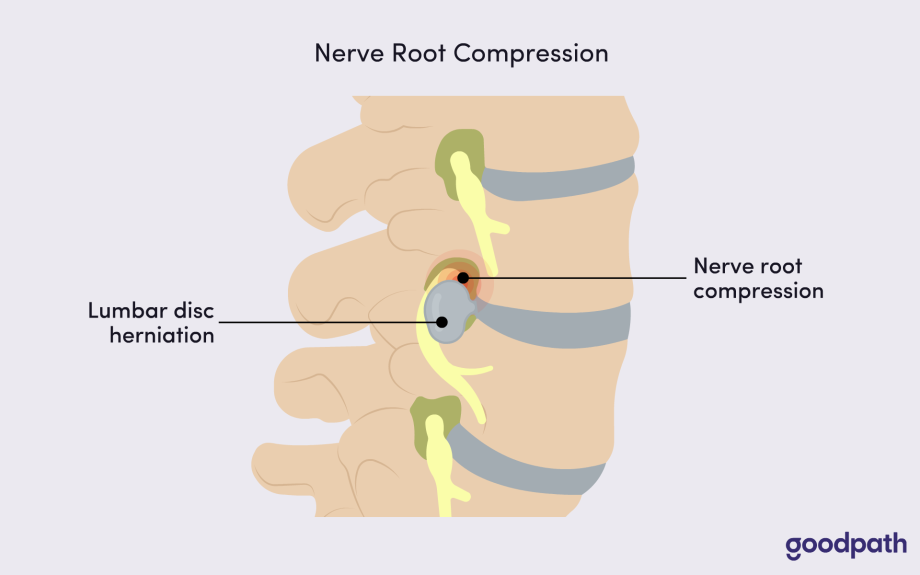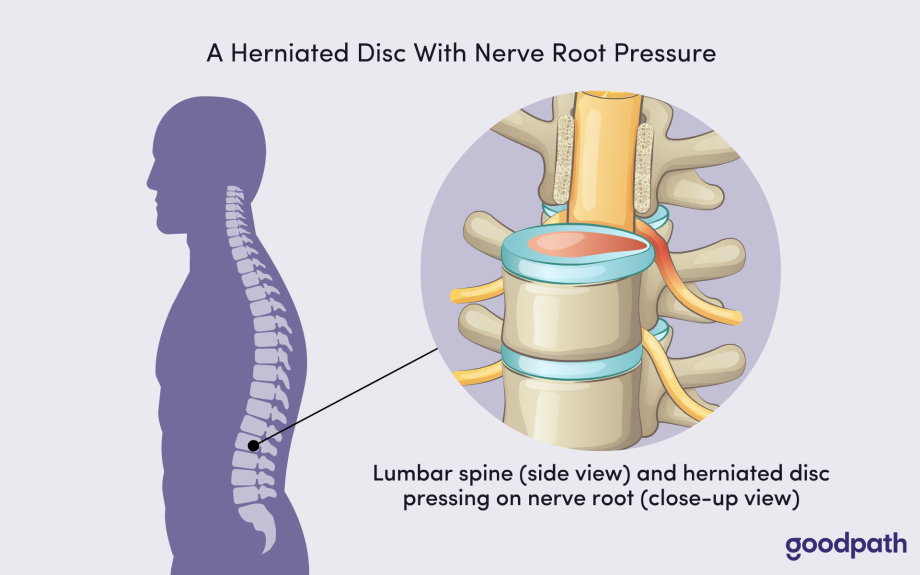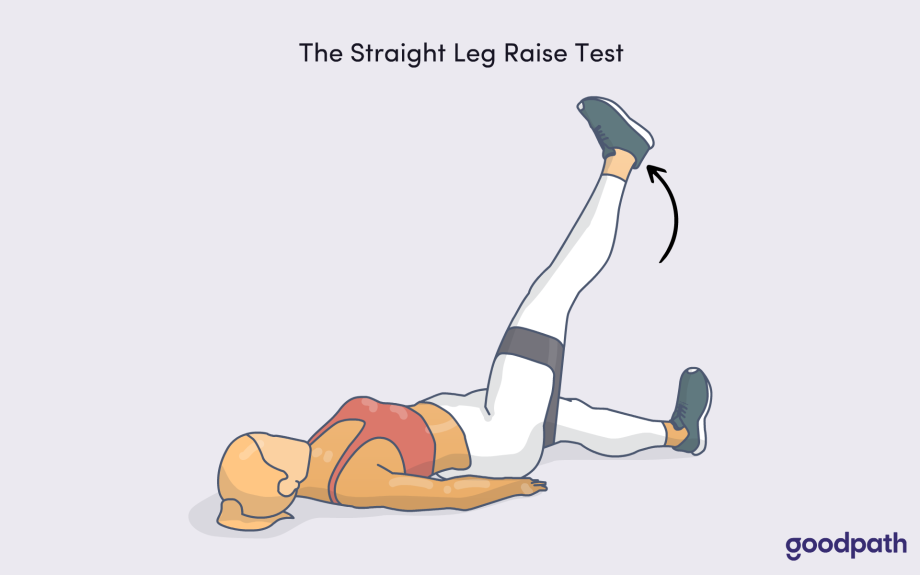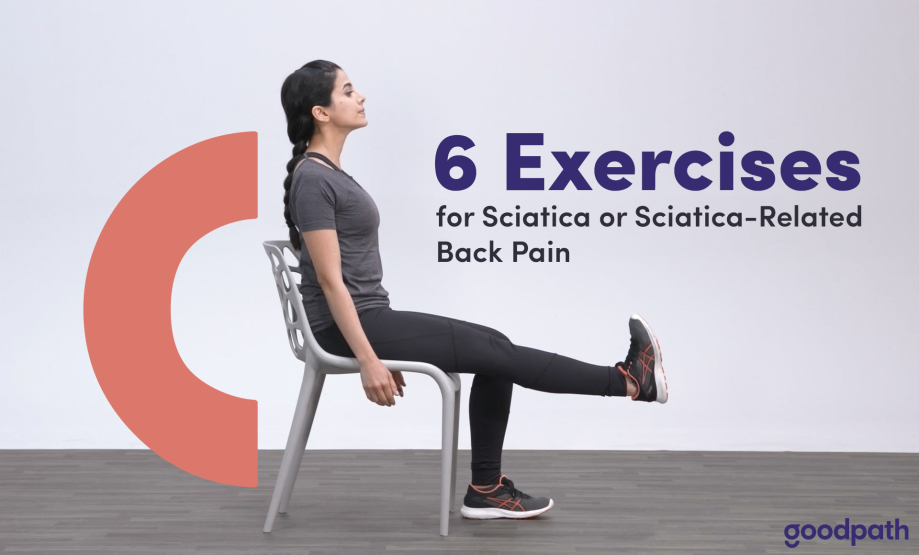6 Exercises for Sciatica or Sciatica-Related Back Pain
Part I: 6 Exercises For Back Pain Due To Sciatica
In order to get the most benefit, you should perform these exercises 3 to 5 times per week for 3 weeks.
Exercise 1: Standing Lumbar Extension
Why it’s beneficial:
It helps to lessen pressure on the sciatic nerve.
Steps
Stand up tall with your back straight and your feet shoulder-width apart.
Put your hands on your hips.
Gently push your hips forward to extend your lower back.
Hold for 2-3 seconds.
Repeat for a total of 10 repetitions (reps).
Exercise 2: Standing Overhead Reach
What are the benefits?
It helps realign the spinal discs, relieving pressure on the sciatic nerve.
Steps
Stand up tall with your legs straight, but relaxed.
Raise both of your arms over your head - this helps stretch your torso and middle and lower back.
Hold for 2 to 3 seconds, then relax and move your arms to your sides.
Repeat 10 times.
Exercise 3: Standing Row with Resistance Band (special elastic band)
Why it’s beneficial:
It can provide pain relief.
Steps
You'll need a resistance band for this exercise. Securely attach the band to something stable, like a doorknob or a staircase post.
Stand up tall with your feet hip-width apart and your knees slightly bent; grasp the end of the band with both of your hands.
Pull the band towards you, bending your elbows. You'll feel your back muscles tighten. Try to keep your forearms parallel with the floor.
Repeat 10 times. Rest for a few moments, then repeat 10 more times.
Exercise 4: Sitting Sciatic Nerve Floss
What are the benefits?
It helps relieve sciatic pain and improve hip flexibility or range of motion.
Important: The sciatic nerve floss exercise should not cause pain, discomfort, and/or other sciatica symptoms. Stop the exercise if this should occur.
Steps
Sit in a chair with your hands by your sides, knees bent, and feet flat on the floor.
Bend forward at your waist with your chin towards your chest.
Slowly straighten your back and lift your chin off of your chest. At the same time, straighten the leg and flex the ankle (point your toes up) on the affected side.
Repeat 5 to 10 times.
Exercise 5: Prone on Elbows
Why it’s beneficial:
It helps realign the discs in your spine, relieving pressure on the sciatic nerve.
Steps
Lie on the floor or ground on your abdomen.
Place your open hands or fists on the floor near your shoulders.
Push up, raising your back and shoulders; keep your forearms on the floor.
Hold this position for 30 seconds.
Repeat 5 to 10 times.
Exercise 6: Cobra Pose
What are the benefits?
It also helps realign discs and relieve pressure on the sciatic nerve.
Important: Cobra Pose is an advanced version of “Prone on Elbows” and a popular yoga pose. You can progress from Prone on Elbows to Cobra Pose. However, do not advance to this exercise if you are unable to perform Prone on Elbows.
Steps
Lie on your abdomen with both hands on the floor near your chest; slowly straighten both arms so that your head, chest, and shoulders are off the floor.
Hold for 10 seconds.
Lower your head, chest, and shoulders.
Repeat 5 to 10 times.
Now that you know some key exercises for sciatica, read on to learn about sciatica.
Part II: Sciatica Information
What Is the Sciatic Nerve?
Sciatica is a problem with the sciatic nerve. The sciatic nerve is the largest nerve in the body. It extends all the way from the lower back down both sides of the body to the buttocks, back of the thighs, back of the calves, and ends at the heels of the feet.
It starts at the lower lumbar and sacral bones of the back (vertebrae), goes through the pelvis and deep muscles including the piriformis muscle - the muscle starts in the front part of the pelvic bone and extends to the buttocks - the glutes area and hip areas.
The sciatic nerve passes through and stimulates movement of the biceps femoris, semitendinosus, and semimembranosus muscles. These three muscles or their associated tendons - where they attach to bones - are known as the “hamstrings.”
The sciatic nerve also stimulates sensations in the skin of the feet and outer portion of the calf.

What Is Sciatica?
Sciatica is a general term that refers to pain in the buttocks that travels to the thigh, past the knee, and may extend to the calf, foot, and toes. It is due to irritation or pressure on the root of the sciatic nerve.
Other medical terms for sciatica include radicular pain, lumbosacral radicular syndrome, nerve root pain, and nerve root entrapment.
Sciatica is usually related to a problem with the spine - the bones, discs, etc. of the back. Regardless of the spinal problem, the radiating leg pain is due to an inflamed or compressed nerve root.

Spinal causes include:
A herniated disc causing pressure on the sciatic nerve root
Spinal stenosis, the narrowing of the area in which the nerves pass through the spine
Degenerative disc disease, a condition with changes in the spinal discs and bones, that is usually associated with normal aging
A vertebra, one of the bones of the spine, slips out of position (spondylolisthesis)
There are some other less-common causes of sciatica unrelated to the spine. They are caused by a problem with the piriformis muscle (e.g. piriformis syndrome), accidents or injury, complications following surgery, etc.
A herniated disc with nerve root pressure is the cause of 90% of sciatica.

What are the Risk Factors for Sciatica?
Smoking; extra body weight; and activities like frequent or heavy lifting, bending, and twisting increase the risk of developing sciatica.
What are the Symptoms of Sciatica?
As you might expect, the symptoms are related to the location and function of the sciatic nerve. The symptoms are pain in the buttocks or hip that spreads down the leg, possibly to the foot. Both the type (aching, sharp, etc.) and severity (mild to severe) of pain, vary. You may also have unusual sensations, like tingling and numbness, and possibly weakness.
How is Sciatica Diagnosed?
The diagnosis of sciatica is based on your symptoms - in particular, pain that radiates or spreads down the leg. One common finding is that leg pain is usually worse than back pain.
Your doctor will also do a neurologic exam and some specific tests. One of the tests is the straight leg raise test, a specific test for sciatic nerve pain. The test checks for pain when your doctor raises your straight leg. If you have increased pain, the test is positive.�

Imaging tests are recommended when a person has severe or worsening neurologic symptoms or when other serious conditions are possible.
What Is The Treatment For Sciatica?
The treatment for sciatica is conservative - that means it doesn’t involve surgery or spinal injections. It includes exercises and education about self-care. It may also include non-steroidal anti-inflammatory drugs (NSAIDs) or supplements. One important part of sciatica treatment is to stay active and avoid bedrest. In people with severe or long-lasting sciatica, spinal injections and surgery may be options.
As discussed in Part I, an exercise program is part of the treatment for sciatica. The exercises help to:
Realign spinal discs
Lessen pressure on the sciatic nerve
Lessen pain
Improve flexibility and movement
Staying mobile and decreasing pressure on the nerve roots are two goals of exercise. We selected six easy and effective sciatica pain exercises, but there are other exercises to help with this type of back pain.
Do People Recover from Sciatica?
The simple answer is yes - most people do recover from sciatica. Studies of people with sciatica found different rates of recovery depending on the types of people and their treatment. The time to recovery ranged from two weeks to three months.
Can Sciatica be Prevented?
You can help to prevent sciatica by following healthy lifestyle practices, so:
Keep a healthy weight by following a Mediterranean-type diet
Don’t smoke or use other tobacco products
Stay active - continue or start exercising
Improve strength with resistance exercises and flexibility with stretches
Maintain good body alignment by keeping your head up, your ears over your shoulders, and your back straight
Avoid twisting, keep your back straight, and use your legs when lifting
You can also use the exercises for sciatica in Part I.
When Should I Contact My Doctor?
At times there may be serious reasons for sciatica pain. Contact your doctor if you have the following:
Sudden increase in pain
Severe pain
Sudden or worsening numbness, tingling, or weakness
Inability to urinate (urinary retention) or control your bowel movements (incontinence of stool)
How Goodpath Can Help
It takes lifestyle changes and dedication to reduce pain (especially chronic pain) and to prevent it from recurring. These exercises and information are a step in the right direction.
At Goodpath, we’re here to help. Take our back pain assessment now, and we can build an integrative plan specifically for you and your needs. Your program may include:
Personalized exercise videos
Supplements or over-the-counter medications (OTCs)
Mind-body/stress-reducing treatments
Nutritional/diet support
